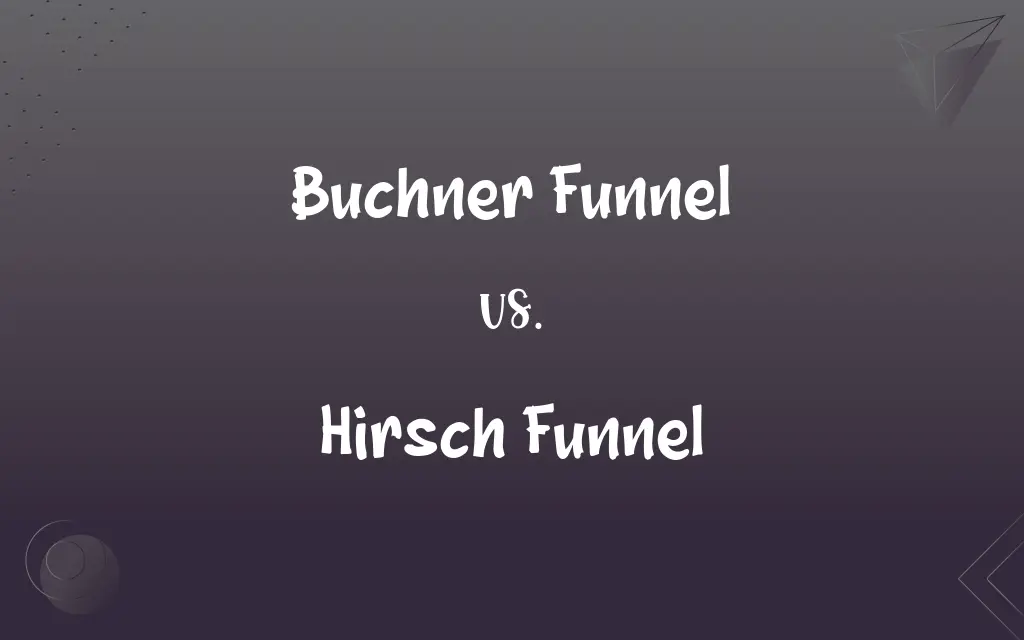Buchner Funnel vs. Hirsch Funnel: What's the Difference?
Edited by Aimie Carlson || By Janet White || Published on February 21, 2024
A Buchner funnel is a flat-bottomed, porcelain funnel used for vacuum filtration, while a Hirsch funnel is a smaller, cone-shaped funnel used for the same purpose, typically in smaller-scale filtrations.

Key Differences
A Buchner funnel is a piece of laboratory equipment used primarily in filtration. It has a flat, perforated base which separates solid particles from liquids. This funnel is often made of porcelain or plastic. In contrast, a Hirsch funnel, while serving a similar purpose, is distinct in its design and use. It is smaller, conical, and typically used for smaller quantities of solution. The Hirsch funnel is also used for filtration but is more suitable for fine precipitates.
The Buchner funnel is typically used with a vacuum system, which accelerates the filtration process by drawing the liquid through the filter paper placed at the bottom of the funnel. The Hirsch funnel can also be used with a vacuum, but due to its smaller size, it is less efficient for large volumes of liquid. The Buchner funnel's broader base allows for more filter paper and, therefore, a larger filtration surface area compared to the Hirsch funnel.
In terms of construction, Buchner funnels are often more robust and suitable for handling larger quantities of solution. Their design makes them ideal for use in industrial or educational laboratory settings. The Hirsch funnel, with its smaller and more delicate build, is more commonly used in specialized chemical analyses where only small quantities of precipitate are present.
Maintenance and cleaning of these funnels also differ. The Buchner funnel, being larger, requires more careful cleaning to ensure that all residues are removed from its wider surface. The Hirsch funnel, though smaller, can be more challenging to clean thoroughly due to its narrow conical shape, especially if the precipitate is fine and sticks to the funnel's surface.
The choice between a Buchner and a Hirsch funnel often comes down to the scale of the operation and the nature of the precipitate. For larger-scale filtrations with coarse precipitates, a Buchner funnel is more appropriate, while for small-scale filtrations with fine precipitates, a Hirsch funnel is more suitable.
ADVERTISEMENT
Comparison Chart
Shape
Flat-bottomed
Conical
Size
Larger
Smaller
Use Case
Large volumes, coarse precipitates
Small volumes, fine precipitates
Construction
More robust, often porcelain or plastic
More delicate, typically glass or porcelain
Filtration Efficiency
Higher for large quantities
More suitable for small quantities
ADVERTISEMENT
Buchner Funnel and Hirsch Funnel Definitions
Buchner Funnel
A Buchner funnel is used in both educational and industrial laboratories for filtration.
In our school lab, the Buchner funnel is a commonly used apparatus for demonstrating filtration techniques.
Hirsch Funnel
A Hirsch funnel is a small, cone-shaped apparatus used in laboratory filtration.
To filter the tiny amount of precipitate, we utilized a Hirsch funnel.
Buchner Funnel
A Buchner funnel is a laboratory apparatus used to separate solids from liquids.
The Buchner funnel proved essential in isolating the crystalline precipitate from its solvent.
Hirsch Funnel
It is a smaller variant of the Buchner funnel, often used in specialized chemical analysis.
In analytical chemistry, the Hirsch funnel is favored for its small scale and efficiency.
Buchner Funnel
This funnel is a key tool in chemistry for accelerating the filtration process.
Setting up the Buchner funnel, we prepared for the final stage of our experiment.
Hirsch Funnel
A Hirsch funnel is ideal for fine precipitates in chemical experiments.
For our experiment's delicate precipitate, the Hirsch funnel provided the precision we needed.
Buchner Funnel
A Buchner funnel is a flat-bottomed, perforated device used for vacuum filtration.
We used a Buchner funnel to quickly filter the solution in our chemistry lab.
Hirsch Funnel
This funnel is typically used for filtering small volumes of liquids.
Given the small sample size, a Hirsch funnel was the perfect choice for the task.
Buchner Funnel
A Buchner funnel is characterized by its wide base and compatibility with vacuum systems.
The Buchner funnel's wide base allowed us to filter large volumes of liquid efficiently.
Hirsch Funnel
A Hirsch funnel, with its conical shape, is suited for precise laboratory work.
Our lab's Hirsch funnel was essential for conducting accurate and fine filtrations.
FAQs
Can a Buchner funnel be used without a vacuum?
While possible, its efficiency is greatly enhanced with a vacuum.
What is a Hirsch funnel?
A smaller, cone-shaped funnel used for filtering fine precipitates.
How does a Buchner funnel work?
It uses vacuum suction to pull liquid through a filter, separating solids.
Can Buchner and Hirsch funnels be used interchangeably?
Not ideally, as they're designed for different scales of filtration.
What size filter paper is used with a Buchner funnel?
Depends on the funnel's size, but generally larger than for a Hirsch funnel.
What materials are Buchner funnels made of?
Often porcelain or plastic, designed for durability.
What materials are Hirsch funnels typically made from?
Usually glass or porcelain for chemical resistance.
How do you set up a Buchner funnel for filtration?
Place it atop a flask, insert appropriate filter paper, and apply vacuum.
What is a Buchner funnel?
A flat-bottomed, perforated funnel used for vacuum filtration in labs.
What is the typical use of a Hirsch funnel?
It's used for filtering small volumes of liquids and fine precipitates.
What precipitates are best for a Hirsch funnel?
Fine precipitates in small quantities.
Is a Hirsch funnel suitable for large-scale filtration?
No, it's designed for small-scale, precise filtrations.
Are Buchner funnels used in educational settings?
Yes, they're common in school and university labs for teaching filtration.
Is a Hirsch funnel easy to clean?
It requires careful cleaning due to its narrow shape.
Why choose a Buchner funnel for a lab experiment?
Ideal for larger volumes and coarse precipitates.
What's the cleaning process for a Buchner funnel?
Rinse thoroughly with appropriate solvents and water to remove residue.
What's a common application for a Buchner funnel in industry?
Used in pharmaceutical and chemical industries for bulk filtration.
Are there different sizes of Hirsch funnels available?
Yes, but they are generally smaller than Buchner funnels.
Can Hirsch funnels be used with vacuum filtration?
Yes, they are often used with vacuum systems.
What's the main advantage of a Hirsch funnel?
Its precision and suitability for small, fine filtrations.
About Author
Written by
Janet WhiteJanet White has been an esteemed writer and blogger for Difference Wiki. Holding a Master's degree in Science and Medical Journalism from the prestigious Boston University, she has consistently demonstrated her expertise and passion for her field. When she's not immersed in her work, Janet relishes her time exercising, delving into a good book, and cherishing moments with friends and family.
Edited by
Aimie CarlsonAimie Carlson, holding a master's degree in English literature, is a fervent English language enthusiast. She lends her writing talents to Difference Wiki, a prominent website that specializes in comparisons, offering readers insightful analyses that both captivate and inform.
































































